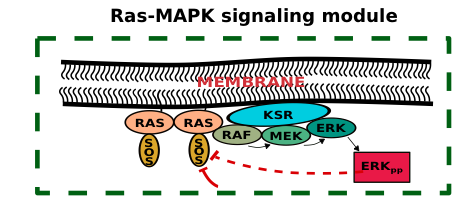Negative feedback self-regulation contributes to robust and high-fidelity transmembrane signall transduction
Negative feedback self-regulation contributes to robust and high-fidelity transmembrane signall transduction
M.A. Serrano, M. Jurado, R. Reigada.
J. R. Soc. Interface, 10 (2013) 20130581.

Sketch of the Ras-MAPK signalling motif studied in the article. Two negative feedback controls in the motif are compared: external control (red sòlid line) and a self-regulation (red dashed line).
In this article we have presented a minimal motif model for transmembrane cell signalling based on the Ras-MAPK signalling pathway. The model assumes signalling events taking place in spatially distributed nanoclusters regulated by a birth/death dynamics. The combination of these spatio-temporal aspects can be modulated to provide a robust and highfidelity response behaviour without invoking sophisticated modelling of the signalling process as a sequence of cascade reactions and cycles, and fine-tuned kinetic parameters. Our results show that the fact that the distributed signalling events take place in nanoclusters with a finite lifetime regulated by local production is sufficient to obtain a robust and high-fidelity response. No external control of the signalling process is required to obtain a robust response.
